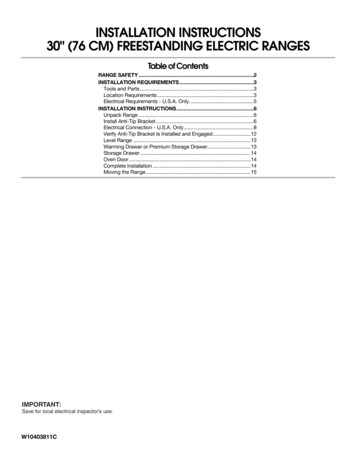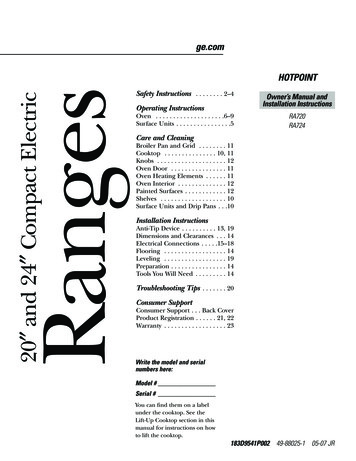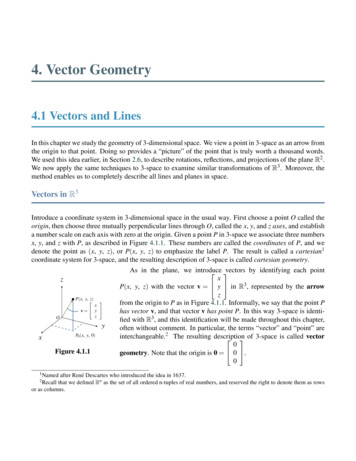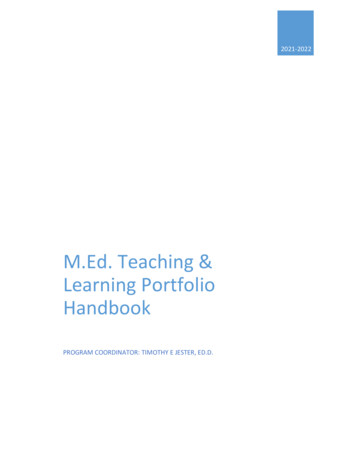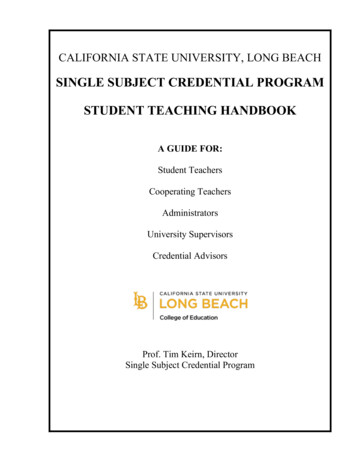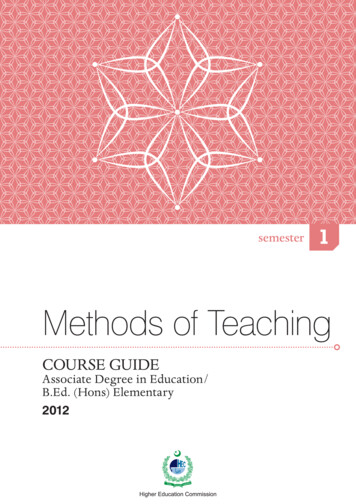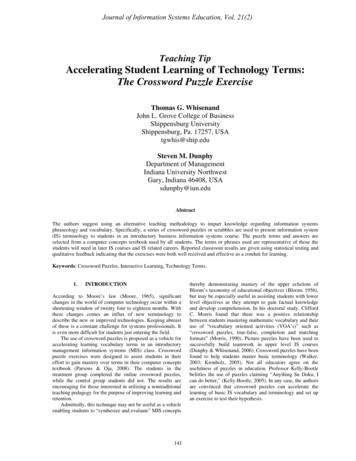
Transcription
Journal of Information Systems Education, Vol. 21(2)Teaching TipAccelerating Student Learning of Technology Terms:The Crossword Puzzle ExerciseThomas G. WhisenandJohn L. Grove College of BusinessShippensburg UniversityShippensburg, Pa. 17257, USAtgwhis@ship.eduSteven M. DunphyDepartment of ManagementIndiana University NorthwestGary, Indiana 46408, USAsdunphy@iun.eduAbstractThe authors suggest using an alternative teaching methodology to impart knowledge regarding information systemsphraseology and vocabulary. Specifically, a series of crossword puzzles or scrabbles are used to present information system(IS) terminology to students in an introductory business information systems course. The puzzle terms and answers areselected from a computer concepts textbook used by all students. The terms or phrases used are representative of those thestudents will need in later IS courses and IS related careers. Reported classroom results are given using statistical testing andqualitative feedback indicating that the exercises were both well received and effective as a conduit for learning.Keywords: Crossword Puzzles, Interactive Learning, Technology Terms.1.INTRODUCTIONAccording to Moore’s law (Moore, 1965), significantchanges in the world of computer technology occur within ashortening window of twenty four to eighteen months. Withthese changes comes an influx of new terminology todescribe the new or improved technologies. Keeping abreastof these is a constant challenge for systems professionals. Itis even more difficult for students just entering the field.The use of crossword puzzles is proposed as a vehicle foraccelerating learning vocabulary terms in an introductorymanagement information systems (MIS) class. Crosswordpuzzle exercises were designed to assist students in theireffort to gain mastery over terms in their computer conceptstextbook (Parsons & Oja, 2008). The students in thetreatment group completed the online crossword puzzles,while the control group students did not. The results areencouraging for those interested in utilizing a nontraditionalteaching pedagogy for the purpose of improving learning andretention.Admittedly, this technique may not be useful as a vehicleenabling students to “synthesize and evaluate” MIS concepts141thereby demonstrating mastery of the upper echelons ofBloom’s taxonomy of educational objectives (Bloom, 1956),but may be especially useful in assisting students with lowerlevel objectives as they attempt to gain factual knowledgeand develop comprehension. In his doctoral study, CliffordC. Morris found that there was a positive relationshipbetween students mastering mathematic vocabulary and theiruse of “vocabulary oriented activities (VOA’s)” such as“crossword puzzles, true-false, completion and matchingformats” (Morris, 1990). Picture puzzles have been used tosuccessfully build teamwork in upper level IS courses(Dunphy & Whisenand, 2006). Crossword puzzles have beenfound to help students master basic terminology (Walker,2003; Kronholz, 2005). Not all educators agree on theusefulness of puzzles in education. Professor Kelly-Bootlebelittles the use of puzzles claiming “Anything Su Doku, Ican do better,” (Kelly-Bootle, 2005). In any case, the authorsare convinced that crossword puzzles can accelerate thelearning of basic IS vocabulary and terminology and set upan exercise to test their hypothesis.
Journal of Information Systems Education, Vol. 21(2)2. LEARNING THROUGH CROSSWORD PUZZLESCrossword puzzles have been used in education for manyyears, but can they really improve learning? Franklin, Peat,and Lewis (2003) found crossword puzzles were useful aidsto learning for first year biology students. Solving crosswordpuzzles involves many of the skills useful for IS students andprofessionals including: spelling, reasoning, makinginferences, evaluating choices, and drawing conclusions.Weisskireh (2006) reported that “Using a specially designedcrossword puzzle provides an easy and engaging way forstudents to review concepts in preparation for a test” (p.200).To solve a crossword puzzle, a student must be able toidentify and understand the terms being used. This willfrequently involve learning new vocabulary or terminology.It can also involve differentiating between similar words orphrases. Correctly deciphering a crossword also requiresprecise spelling, which may require students to read theirtextbook assignments more thoroughly. Crossword puzzlesare generally associated with game playing, fun, andrecreation, and therefore can be less intimidating for studentsas a learning tool. Goh and Hooper (2007) concluded that theuse of a crossword puzzle game “provided a unique sense ofmotivation” and challenged the students “because it requiredboth lateral and longitudinal thinking to solve the puzzle” (p.450). Puzzle solving involves an active style of learning, andwill engage students with the material more than passivetechniques. Crossword puzzles can also appeal to variousstudent learning styles. Visual learners will enjoy using theirstrong puzzle-solving skills. Using stepwise reasoning,auditory learners can enjoy mastering the puzzle. Kinestheticlearners enjoy the multi-task strategies required to solve acrossword. For all the above reasons, crossword puzzles arean excellent choice to use for this particular study.Building on a strong base of vocabulary terms is crucialto the student starting to learn a new or expanding disciplinesuch as IS. It is also critical in workplace success. Accordingto studies by researcher and educator Johnson O’Connor, aperson’s vocabulary is the single most important factor inoccupational success (Broadley, 2002). A strong vocabularyis an indicator of intelligence. Those who are able tocommunicate clearly and speak with authority on a givensubject are more likely to be looked upon with respect in theclassroom or the workplace. They are also often the firstones considered for promotions, or in the case of students,job placement or hiring.3. METHODOLOGYThe crossword puzzle exercises were provided to students inthree sections of an introductory business informationsystems course totaling ninety two students. The terms andphrases used in the crossword puzzle were taken from thecomputer concepts textbook used in the course. All studentswere provided with a list of the terms to be included in a quizat the end of each chapter. One half of the students weregiven access to the crossword puzzle exercises to help themlearn the key words, phrases, and their meanings(Appendices A and C). The crossword puzzles were webbased, interactive puzzles and provided three types of helpbuttons: reveal a letter; reveal a word; and check. The firsttwo option buttons would disclose the letter or word wherethe student was within the puzzle. The check button allowedthe students to check the spelling or correctness of theentered crosswords and could be used anytime during thesolution process. A quiz for each chapter’s terms was givenone week after the list of terms were made available andaccess to the puzzles’ website was given to the treatmentsubjects. To ensure that the treatment subjects worked thecrossword puzzle at least one time, they had to submit acompleted puzzle to the instructor prior to the quiz. For thequiz on the second chapter’s vocabulary, the group’s roleswere reversed. The original control subjects were givenaccess to the puzzle and the original treatment group’ssubjects were not.4. RESULTS: QUANTITATIVE FINDINGSThose students who used the crossword puzzles as a studyaid on average scored higher than those students who didnot. As seen below, the treatment group’s mean score was12.6 points higher than the control group’s mean score (seeTable 1).Mean Quiz ScoresControlGroup52.3TreatmentGroup64.9Number of Students4250Table 1. Quiz Score ResultsThe data from the quizzes were analyzed using anunpaired t-test and the results were: t -2.68; standarddeviation 22.61; degrees of freedom 90.The probability of this result, assuming the nullhypothesis of no difference in mean scores between controland treatment groups, is 0.01. The authors find theseresults highly significant but plan on repeating theexperiment with increased sample sizes.5. RESULTS: QUALITATIVE FINDINGSAt the end of the study, the subjects were asked to completethe crossword assessment survey adapted from Berry andMiller (2008) to assess their perceptions of the experience ofworking the crossword puzzles. Students indicated theirextent of agreement with 10 statements on a 5-level Likertscale (strongly agree, agree, neutral, disagree, and stronglydisagree). The questions and the results are depicted in Table2.As shown, the students rated the crossword exercise asan effective tool in building a vocabulary of technical terms(4.343 mean), assisting their recall of the definitions andterms (4.333 mean), and improving their understanding andknowledge of technology related terms (4.088 mean).Paralleling Weisskireh’s (2006) results, the students deemedthe use of crossword puzzle exercises as a fun way to learnthe material (4.143 mean) and asked for more of them forsubsequent chapters’ vocabulary (4.459, the highest meanscore). The overall mean score for all sections and questionswas 4.23 out of 5.The final survey question asked the respondents toprovide any additional comments about their experience with142
Journal of Information Systems Education, Vol. 21(2)the exercise. Out of sixteen written comments, some samplesof the students’ statements include: “It was a magnificent study guide for me ” “I would like to have more crossword puzzles for the otherquizzes.” “I have kinetic and pictorial memory so in using thecrossword puzzle, I understood and retained informationmore readily.”QuestionsDoing the crossword exercise:While there were no serious objections in the comments, onestudent claimed, “I think that if I actually had done thecrossword puzzle that I would have gotten a better grade.”The student perceptions of the crossword puzzleexercises are summarized below.MeanScoreimproved my understanding of the technology terms.4.219helped me enhance my knowledge of the technology terms.4.088assisted me in retaining the content.4.257increased my level of confidence of the terms.4.060assisted me in preparing for the quiz.4.222was a fun way to reinforce my understanding of the technology terms.4.143assisted with my recall of the definitions/terms.4.333forced me to read and/or study the technology terms.4.158was an effective tool in building a vocabulary of technical terms.4.343I would like more exercises like the crossword puzzle.4.459Table 2. Student Perceptions Summary6. DISCUSSION AND CONCLUSIONThis exercise demonstrates that working crosswordpuzzles can help first year students build and maintaintheir vocabulary of technology related terms encounteredin an introductory information systems course. This studyhas shown improved quiz grades with the use ofcrossword puzzles as a learning aid. Based on studentfeedback on the survey, it has generated a high level ofacceptance as a learning tool for this material.Can an IS professor extrapolate these findings to thework within other classes? Most IS classes introduce asignificant number of “new” terms and phrases to thestudents in their classes. The crossword puzzle exercisemay prove to be a meaningful learning experience forbuilding, understanding, and improving retention of thenomenclature of technology first inside the classroom andthen beyond. As such, the authors strongly recommendthe use of crossword puzzles to accelerate studentlearning at both the undergraduate and graduate degreelevels as well as for teaching IS professionals.7. REFERENCESBerry, D.C & Miller, M.G. (2008). “Crossword Puzzles asa Tool to Enhance Athletic Training StudentLearning: Part 2.” Athletic Therapy Today, 13(1),pp.32-34.Bloom, B.S. (Ed.). (1956). Taxonomy of EducationalObjectives. New York: David McKay Company Inc.Broadley, M.E. (2002). Your Natural Gifts: How toRecognize and Develop Them for Success and SelfFulfillment. Human Engineering Laboratory, Boston,MA.Dunphy, S.M. & Whisenand, T.G. (2006). “BuildingCamaraderie Through Information Processing: Wuzzle Picture Puzzle Exercise.” The Journal ofInformation Systems Education, 17(1), 11-16.Franklin, S., Peat, M., & Lewis, A. (2003). “Nontraditional interventions to stimulate discussion: Theuse of games and puzzles.” Journal of BiologicalEducation, 37 (2), pp. 79 - 84.Goh, T. & Hooper, V. (2007). “To TxT or Not to TxT:That’s the Puzzle.” The Journal of InformationTechnology Education, Vol. 6, pp. 441 – 453.Kelly-Bootle, S. (2005). “Anything Su Doku, I can dobetter.” ACM Queue. New York: Dec 2005. 3 (10), p.56.Kronholz, J. (2005). “To tackle new SAT, perhaps yourneed a new study device; test-prep CD’s, puzzles, cellphone software hit a market of nonreaders.” WallStreet Journal. March 8. p.1.Moore, G.E. (1965). “Cramming more components ontointegrated circuits.” Electronics, 38(8), April 19,1965.Morris, C. (1990). “The relationship between vocabularyoriented activities and mathematics achievementscores of community college students on the MBPA.”Dissertation, Tampa, Florida: University of SouthFlorida.Parsons, J.J. and Oja, P. (2008). New Perspectives onComputer Concepts, 10th Ed., Thompson CourseTechnology, Boston, MA.Walker, B. (2003). “A playful tutor who chalks upresults.” Regeneration & Renewal. Oct. 17, 2007, p.15.Weisskireh, R.S. (2006). “An analysis of instructorcreated crossword puzzles for student review.”College Teaching, 54(1), pp. 198-201.
Journal of Information Systems Education, Vol. 21(2)AUTHOR BIOGRAPHIESThomas G. Whisenand received his Ph.D. from theUniversity of Maryland BaltimoreCounty. He is a Professor Emeritus a.Hisresearch interests include humancomputerinteraction,web-basedlearning systems, and database systemsdesign.Steven M. Dunphy received his Ph.D. from IndianaUniversity’s Kelley School of Business.He is an Associate Professor ofManagement at Indiana UniversityNorthwest in Gary, Indiana. Hisresearch interests include small groupdevelopmentandinterpersonalcommunication.144
Journal of Information Systems Education, Vol. 21(2)Appendix A:Computers & Digital Basics: Keywords and CrosswordWeaver.comACROSS1 When a hacker poses as a legitimaterepresentative of an official organization inorder to persuade you to disclose highlyconfidential information4 Personal computer, workstation, or othersoftware that requests data from a server6 Converts colors and sounds into numbers,which can be represented by bits7 An area of the computer that temporarilyholds data that is waiting to be processed,stored or output10 Makes it possible to convert letters, sounds,and images into electronic signal (2 words)13 A collection of files organized as a gianthypertext15 Translates all of the instructions in aprogram as a single batch16 1 or 0 in a digital format19 requires only seven bits for each character20 An integrated circuit designed to processinstructions21 Projects that promote copying, freedistribution, peer review, and usermodification (2 words)22 The end product of the conversion of sourcecode by compilers and interpreters (2words)24 Fetches each instruction (2 words)DOWN2 The interception of information sent out overcomputer networks3 A personal journal posted on the Web4 Series of instructions that tell the computerhow to carry out processing tasks (2 words)5 Process by which several technologies withdistinct functionalities evolve to form a145single product8 List of instructions that a microprocessorcan perform (2 words)9 bits to represent one character11 Super thin slice of semi-conducting materialpacked with microscopic circuit elementssuch as wires, transistors, capacitors, logicgates, and resistors (2 words)12 The master controller for all of the activitiesthat take place within a computer (2 words)14 Converts one instruction at a time while theprogram is running17 Uses 16 bits and provides codes for 65,000characters18 Hold data that is being processed23 “Brain” of the computer, used for processingdata
Journal of Information Systems Education, Vol. 21(2)Appendix B:Computers & Digital Basics SolutionC L I EOMPUTD AERPROGURNAIM I C RODEN TCM E M ONVT A R ERGW EINNCTEERO P R ORETERMR YP RBBC EP H I SND IFIFNIE S E NTGRUC O MI TIONS S O RETH I N GG IT AP IA SO P EA C H I N E C OPC O N T R O L U N I T146BLT I Z A T I O NGBYT I O NEIONPTL E RERGARTARC I ITENEGGDISCSYITN S O U R C ETCRD EUSMIT
Journal of Information Systems Education, Vol. 21(2)Appendix CComputer Hardware: Keywords and osswordWeaver.comACROSS3 Processor can begin executing aninstruction before it completes theprevious instruction8 Area of the hard drive used whenthe program exceeds the allocatedspace (2 words)9 Special high-speed memory thatallows a microprocessor to accessdata more rapidly than frommemory located elsewhere on thesystem board11 1 billionth of a second12 Microscopic electronic part thatholds bits that represent data13 Requires electrical power to holddata14 Peripheral component interconnect15 The speed at which a screen isrepainted. (2 words)16 Technique for increasing the speedof a computer component, such as1719202123a processor, graphics card,motherboard, or memoryThe maximum number of horizontaland vertical pixels that aredisplayed on the screenCircuitry to carry data from onecomponent to another (2 words)Able to print on both sides of thepaper (2 words)Multiple instructions executed atthe same time (2 words)Read-only memory holds thecomputer’s startup routineDOWN1 A device that not only providessurge protection but also furnishesyour computer with battery backuppower during a power outage2 Billion cycles per second4 temporary holding area for data,application program instructions,147and the operating system5 The circuitry that transports data toand from the microprocessor (3words)6 Average time it takes a computerto locate data on the storagemedium and read it. (2 words)7 When a read-write head runs into adust particle or some othercontaminant on the disk (2 words)10 The small dots of light that form animage12 Number of colors that a monitorand graphics card can display (2words)18 Lighter non pitted surface areas ofthe disk19 Rewritable DVD. Uses CD-liketechnology but with DVD storagecapacity (hyphenated)22 Liquid crystal display produces animage by manipulating light withina layer of liquid crystal cells
Journal of Information Systems Education, Vol. 21(2)Appendix DComputer Hardware SolutionUP I P E L I NSV I R T UGI N GRGAA L M E M OHPEN AA P A C I T O R SXTA T I L EZP CLE F R E S H R A T EFAR YC AOCN O S E CCTSOSSV O LITODIREMDBEO V E R C L O C K I N GUPR E S O L U TD A T A B U SAVHD U P L E X P R I N T EDDP A R A L L E L P R O C E S S IR O MCWD148HC H EAO N DCRASHI O NRN G
Information Systems & ComputingAcademic ProfessionalsSTATEMENT OF PEER REVIEW INTEGRITYAll papers published in the Journal of Information Systems Education have undergone rigorous peer review. This includes aninitial editor screening and double-blind refereeing by three or more expert referees.Copyright 2010 by the Information Systems & Computing Academic Professionals, Inc. (ISCAP). Permission to make digitalor hard copies of all or part of this journal for personal or classroom use is granted without fee provided that copies are not madeor distributed for profit or commercial use. All copies must bear this notice and full citation. Permission from the Editor isrequired to post to servers, redistribute to lists, or utilize in a for-profit or commercial use. Permission requests should be sent tothe Editor-in-Chief, Journal of Information Systems Education, editor@jise.org.ISSN 1055-3096
John L. Grove College of Business Shippensburg University Shippensburg, Pa. 17257, USA tgwhis@ship.edu Steven M. Dunphy Department of Management Indiana University Northwest Gary, Indiana 46408, USA sdunphy@iun.edu Abstract The authors suggest using an alternative teaching methodology to impart knowledge regarding information systems

